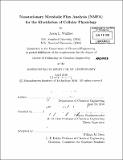Nonstationary metabolic flux analysis (NMFA) for the elucidation of cellular physiology
Author(s)
Walther, Jason L
DownloadFull printable version (20.76Mb)
Alternative title
NMFA for the elucidation of cellular physiology
Nonstationary MFA for the elucidation of cellular physiology
Nonstationary metabolic flux analysis for the elucidation of cellular physiology
Other Contributors
Massachusetts Institute of Technology. Dept. of Chemical Engineering.
Advisor
Gregory Stephanopoulos.
Terms of use
Metadata
Show full item recordAbstract
Many current and future applications of biological engineering hinge on our ability to measure, understand, and manipulate metabolism. Many diseases for which we seek cures are metabolic in nature. Small-molecule biomanufacturing almost always involves metabolic engineering. Biofuels, a current topic of great interest, is essentially a metabolic problem. Even bioprocesses that involve complex products, such as enzyme or antibody manufacturing, still rely on a healthy and optimal metabolism and can benefit from a greater understanding therein. A cell's metabolic flux distribution has been proposed to be one of the most solid and meaningful indicators and descriptors of metabolism. Metabolic fluxes represent integrative information and are a function of gene expression, translation, post-translational modifications, and protein-metabolite interactions. Metabolic flux analysis (MFA) is a powerful method for determining these flux distribution through a cellular reaction network. However, MFA has experimental limitations (most notably, a requirement for isotopic steady state) that restrict the scope of biological contexts in which it can be applied. Nonstationary metabolic flux analysis (NMFA) has recently emerged as a combined computational and experimental method that improves upon MFA with the capacity to estimate fluxes even during periods of isotopic transience in metabolism, allowing flux analysis to be applied in a broader range of experimental settings. In this thesis, we have developed and applied robust and efficient NMFA tools and techniques and applied them to understand various cellular physiologies. We built a software package (MetranCL) that combines the elementary metabolite unit (EMU) framework, a new network decomposition strategy termed block decoupling, and a customized differential equation solver. MetranCL performs flux estimations as much as 5000 times faster than the previous state-of-the-art NMFA methods, opening entirely new types of biological systems to the possibility of flux analysis. We applied MetranCL to a simulated large network representing E. coli metabolism and were able to successfully estimate reaction fluxes and metabolite concentrations and their 95% confidence intervals. We investigated a number of different experimental arrangements of measurement time points, and found that in general, measurements earlier in isotopic transience were more sensitive to network parameters and yielded more precise confidence intervals. We also observed that the addition of concentration measurements significantly increased estimate quality. We next used NMFA to compute fluxes from actual experimental measurements taken from brown adipocytes. We designed an appropriate network and successfully fitted simulated measurements to actual measurements (taken at 2, 4, and 6 hours after introducing tracer). A flux distribution was obtained that indicated a high level of pyruvate cycling, a low flux through the TCA cycle, and high lactate production. We developed computational and experimental tools to assist with the design of flux analysis experiments. We built a simulator that calculates the effect of different tracers on flux estimate precision and used it to study a range of different glucose and glutamine tracers in carcinoma metabolism. Of all the stand-alone tracers we tested, we found that [1,2- 13C2 ]glucose estimated flux distributions with the greatest precision. We built upon this work by constructing an evolutionary algorithm to generate optimal tracer mixtures for different organisms and their respective metabolisms. We applied this algorithm to the same cancer network and found optimal tracer mixtures for the system. We ran experiments with an optimized tracer mixture and compared it to results from typical tracers and saw significant improvements in flux precision. Finally, we applied these methods and tools to evaluate and understand the flux distribution and metabolism of a lipid-overproducing strain of the yeast Yarrowia lipolytica. Since NMFA of this organism required metabolite extracts taken at very precise and proximate time points, we built a rapid sampling apparatus to draw and quench samples of Yarrowia cell culture with a one-second time step. After conducting NMFA under different environmental conditions and at different stages of growth, we found that lipid synthesis fluxes increased when aeration of the cell culture was increased, and observed several corresponding changes in the intracellular flux distribution explaining the overall change in metabolism that occurs with this shift in environmental conditions. In particular, we found that Yarrowia primarily powers lipid production by regulating flux through the pentose phosphate pathway.
Description
Thesis (Ph. D.)--Massachusetts Institute of Technology, Dept. of Chemical Engineering, 2010. Cataloged from PDF version of thesis. Includes bibliographical references (p. 247-260).
Date issued
2010Department
Massachusetts Institute of Technology. Department of Chemical EngineeringPublisher
Massachusetts Institute of Technology
Keywords
Chemical Engineering.